
Twenty Thousand Leagues under the Sea by Jules Verne
Author: Jules Verne
Published: 1869-70
Genre: Adventure, science fiction
Read Twenty Thousand Leagues under the Sea online at PageVio
Jules Verne‘s Twenty Thousand Leagues under the Sea is a seminal work of science fiction that has captivated readers for generations. This classic novel takes audiences on an extraordinary underwater adventure aboard the enigmatic submarine, the Nautilus. Through the eyes of Professor Aronnax, readers encounter the reclusive and brilliant Captain Nemo, who commands this state-of-the-art vessel.
Verne’s novel is not just a tale of thrilling escapades but also an exploration of human ingenuity and the mysteries of the ocean. The book expertly combines scientific knowledge with creative storytelling, making it a must-read for fans of adventure and science fiction alike. The vivid descriptions of underwater landscapes and marine life are both educational and mesmerizing.
Readers who embark on this literary journey will find themselves immersed in a world where the boundaries of the possible are continually expanded. The impact of Twenty Thousand Leagues under the Sea on literature and popular culture is undeniable, solidifying its place as a timeless and influential piece of fiction.
1. Twenty Thousand Leagues Under the Sea Summary
In 1866, ships around the world reported sightings of a mysterious sea monster, speculated to be a gigantic narwhal. In response, the U.S. government organizes an expedition to find and destroy it. Professor Pierre Aronnax, a French marine biologist, is invited to join the expedition along with his manservant Conseil and Canadian whaler Ned Land.
The expedition departs from New York aboard the frigate Abraham Lincoln, traveling south around Cape Horn and into the Pacific Ocean. After five months of searching, the ship encounters the monster near Japan, which damages the ship’s rudder. Aronnax, Land, and Conseil are thrown overboard and discover that the monster is actually a highly advanced submarine. They are captured and brought aboard the vessel, named the Nautilus, and meet its enigmatic commander, Captain Nemo.
The novel follows the trio’s adventures aboard the Nautilus as it navigates the world’s oceans, avoiding land-based governments. Captain Nemo, in self-imposed exile, is driven by a thirst for scientific knowledge and a desire to escape civilization. He reveals that the submarine is electrically powered and conducts advanced marine research. However, Nemo insists that his passengers cannot leave and must stay aboard permanently.
The journey takes them to various oceanic regions, both real and imagined. They explore coral reefs, sunken ships, the Antarctic ice barrier, the transatlantic telegraph cable, and the legendary underwater city of Atlantis. They even reach the South Pole and become trapped in an iceberg, from which they must dig their way out. The passengers engage in underwater hunting, encounter a school of giant squid that attacks the vessel, and attend a funeral for a crew member.
Captain Nemo’s tragic past is hinted at when it is revealed that his homeland was conquered and his family killed by a powerful nation. After a deadly encounter with giant squid, Nemo becomes increasingly withdrawn, and his behavior causes concern among the crew and passengers. Aronnax starts to sympathize with Ned Land’s desire to escape.
When the Nautilus is attacked by a warship from Nemo’s enemy nation, Nemo seeks revenge by ramming the ship, sending it to the ocean floor. This act horrifies Aronnax, who then overhears Nemo’s anguished cries to God. With the situation aboard the Nautilus deteriorating, the trio seizes an opportunity to escape during a stormy night. They find themselves caught in the deadly whirlpool known as the Maelstrom but ultimately manage to reach safety on the coast of Norway. The fate of the Nautilus remains a mystery, to be revealed in Verne’s later work, “The Mysterious Island.”
2. Characters
Professor Pierre Aronnax is a French marine biologist and the narrator of the story. He is taken aboard the Nautilus and becomes intrigued by Captain Nemo.
Conseil, Aronnax’s loyal servant, accompanies him on the journey. He remains calm and intelligent throughout their adventures.
Ned Land is a Canadian whaler. He is skeptical of Captain Nemo’s intentions and consistently thinks about escaping from the Nautilus.
Captain Nemo, the enigmatic commander of the Nautilus, is a man of mystery. His advanced knowledge and disdain for terrestrial politics drive much of the plot.
The Nautilus itself almost acts as a character. It is an advanced submarine, symbolizing Nemo’s brilliance and isolation.
3. Themes and Symbolism
Twenty Thousand Leagues Under the Sea explores several profound themes and symbols.
Freedom is a recurring theme. Captain Nemo seeks liberation from oppressive societies. The ocean symbolizes vast, unbounded liberty.
Depression manifests in Nemo’s behavior. He struggles with his past, illustrating his internal battles amid the broad expanse of the sea.
Science has a prominent role. Nemo’s submarine, the Nautilus, embodies technological progress. The vessel represents human ingenuity and the power of knowledge.
A significant theme is humanity’s relationship with the natural world. The crew’s interactions with marine life highlight both respect and exploitation.
These elements contribute to the novel’s enduring appeal, offering readers insights into various aspects of human experience.
4. Scientific Aspects and Innovations
Jules Verne’s Twenty Thousand Leagues under the Sea explores advanced submarine technology, marine life, and geographical wonders. It showcases groundbreaking innovations and scientific knowledge through detailed descriptions and creative foresight.
Nautilus and Submarine Technology
The Nautilus is a highly advanced submarine, featuring innovations such as electric propulsion and strong hull construction. It operates on electricity, powered by sodium-mercury batteries, which was an imaginative leap for its time.
Captain Nemo’s vessel also comes equipped with advanced diving suits allowing deep-sea exploration. These suits have air supply systems and are designed to withstand high pressures, showcasing Verne’s futuristic vision.
The novel predicts modern submarine technology, with specialized equipment for surface and underwater navigation, pushing the boundaries of 19th-century engineering concepts.
Depictions of Marine Life and Exploration
Twenty Thousand Leagues under the Sea presents a diverse array of marine life observed during the underwater journey. Verne details numerous species, including cetaceans, fish, and aquatic mammals, drawing from current marine biology knowledge.
Captain Nemo acts as a knowledgeable guide, pointing out creatures to the crew and readers alike. Expeditions are described with scientific precision, making references to real ichthyologists and their work. This enhances the educational aspect, merging storytelling with science.
The portrayal of underwater ecosystems is intricate and immersive, revealing the vastness and mystery of the ocean’s depths through the characters’ eyes.
Geographical and Cultural References
The novel’s journey spans significant geographical locations such as the Torres Strait, Suez Canal, Pacific Ocean, and Atlantic. These references ground Verne’s adventurous tale in real-world settings, allowing readers to connect the fictional travels to actual places.
Verne also introduces cultural aspects through Captain Nemo’s encounters and knowledge. The underwater city of Atlantis is mentioned, igniting curiosity about ancient civilizations and their mysteries.
The narrative touches on expeditions to the South Pole, adding to the sense of global exploration. This blend of geographical and cultural elements enriches the adventure, making it both realistic and fantastical.
5. Publication and Historical Context
Twenty Thousand Leagues under the Sea was first published in 1870 and has since influenced both literature and the field of science fiction. Its initial release and translations played a significant role in its global impact.
Initial Release and Translations
Twenty Thousand Leagues under the Sea (originally titled Vingt mille lieues sous les mers) was first published in Paris in 1870 by Jules Verne. The novel quickly gained popularity due to its innovative storyline and detailed descriptions of underwater adventures.
The book was soon translated into multiple languages, making it accessible to a global audience. The first English translation appeared in 1873 and helped to solidify Verne’s reputation.
Influence on Literature and Science Fiction
Jules Verne’s work had a profound impact on the genres of adventure and science fiction. Authors like H.G. Wells and Michael Crichton drew inspiration from Verne’s blend of realism and fantastical elements.
Verne’s portrayal of advanced underwater machinery influenced the depiction of submarines in literature and real-life technological advancements. The narrative techniques and scientific concepts in Twenty Thousand Leagues under the Sea also resonate with themes in the works of Victor Hugo and Charles Darwin, further showcasing Verne’s influence across various fields.
6. Legacy and Adaptations
Twenty Thousand Leagues under the Sea has left a significant impact on many aspects of modern culture and technology. Its influence spans various mediums and has inspired numerous subsequent adaptations and related works.
Influence on Modern Media and Technology
Twenty Thousand Leagues under the Sea has profoundly influenced the science fiction genre and submarine technology. The creation of the Nautilus is considered a visionary concept, predating actual technological advancements in submarine design.
The novel has inspired many filmmakers and television producers. Notable adaptations include the 1954 Disney film starring James Mason and Kirk Douglas. Various television adaptations have also been produced, further cementing the story’s place in popular culture.
Subsequent Works and Crossovers
The novel has led to numerous subsequent works, including The Mysterious Island, another Verne novel that is often seen as a follow-up, featuring characters connected to Captain Nemo. These works have expanded the universe created by Verne, giving readers a broader glimpse into his visionary world.
Various crossovers and adaptations in literature and media have created an expanded universe. These works continue to draw new audiences and maintain the novel’s relevance in contemporary storytelling.
Verne’s adventure tales continue to influence writers and creators who blend adventure storytelling with speculative science, ensuring the enduring legacy of his work.
| Jules Verne Bibliography | |
| Novels | Five Weeks in a Balloon | Journey to the Center of the Earth | From the Earth to the Moon | The Adventures of Captain Hatteras | In Search of the Castaways | Twenty Thousand Leagues Under the Seas | Around the Moon | A Floating City | The Adventures of Three Englishmen and Three Russians in South Africa | The Fur Country | Around the World in Eighty Days | The Mysterious Island | The Survivors of the Chancellor | Michael Strogoff | Off on a Comet | The Child of the Cavern | Dick Sand, A Captain at Fifteen | The Begum’s Fortune | Tribulations of a Chinaman in China | The Steam House | Eight Hundred Leagues on the Amazon | Godfrey Morgan | The Green Ray | Kéraban the Inflexible | The Vanished Diamond | The Archipelago on Fire | Mathias Sandorf | The Lottery Ticket | Robur the Conqueror | North Against South | The Flight to France | Two Years’ Vacation | Family Without a Name | The Purchase of the North Pole | César Cascabel | Mistress Branican | The Carpathian Castle | Claudius Bombarnac | Foundling Mick | Captain Antifer | Propeller Island | Facing the Flag | Clovis Dardentor | An Antarctic Mystery | The Mighty Orinoco | The Will of an Eccentric | The Castaways of the Flag | The Village in the Treetops | The Sea Serpent | The Kip Brothers | Travel Scholarships | A Drama in Livonia | Master of the World | Invasion of the Sea |




